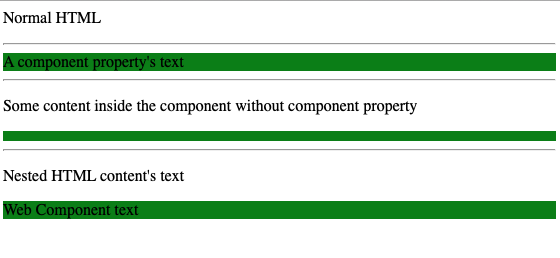Web Components, a first take
Friday, January 17, 2020 3 minWeb Components is a technology to create reusable components for the web. This works by enhancing the developer’s possibilities to be able to create custom HTML elements that consist of their own DOM. All major browsers support Web Components. For others there are polyfills.
Basics
Generally speaking you are able to create something like
| |
Browsers provide the developer with a bunch of APIs to accomplish this. These APIs though are pretty low-level and in some regards a bit more complicated than desired. F.e. a vanilla Web Component could look like this:
| |
Within an HTML page you can then access it like this:
| |
This should then print out something like the following:

Advanced
As you can see this looks like it could become a bit cumbersome when the component should have a bit more functionality. Luckily there are some libraries that make composing Web Components easier by abstracting some of the low level APIs away.
Some of the libraries I looked at are:
- Hybrids: Functional and declarative approach
- LitElement from the Polymer project: OO approach
- StencilJS from the makers of the Ionic Framework: OO approach
Summary
Web Components really have a good idea in mind. I struggled mainly with getting how to style the component which can be quite a challenge as components can consist of quite complex element compositions. It gets “complicated” when you are used to using CSS frameworks and want to reuse some of their base classes. This would mean that you need to have the framework as dependency which is against the idea of reusability. If you go with embedded CSS on the other hand you need to take care that it works across browsers. All in all it’s again a question of what drawbacks to accept.
When you have a lot of elements that compose to components in your web application I think extracting those to Web Components is a good idea though. It keeps your DOM clean and clear so maintenance will become easier.
This post is only scratching the surface as Web Components also are able (and need) to handle state changes (like for example in form elements). You also should look into the workings of shadow DOM if you are developing more complex components with nested elements.